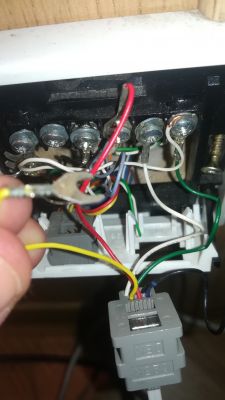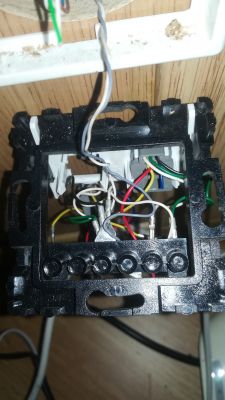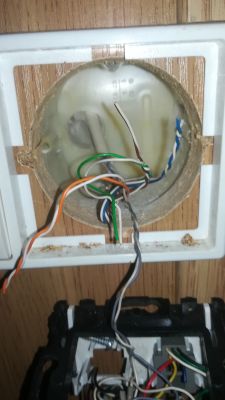Probably someone during cleaning got stuck harder on the can with telephone sockets on the wall and stopped flashing Orange DSL Internet. The problem only occurs in this can, because in a nest in another room is ok.
Generally, there are two sockets in a can, but I want at least one to work, because only one has ever worked.
Four cables come out of the socket:
- yellow
- red
- white
- green

There are 6 screws on the top of the can:
counting from the left:
- yellow cable is not connected anywhere (probably culprit)
- red goes to screw number 4
- white to screw No. 5
- green to screw No. 6

gray and white cables are connected from the wall:
- gray to screw No. 4 (together with red)
- white to screw No. 6 (together with green)

All that remains in the wall looks like this:

Could anyone help how to connect it to get it working again?
I will add that on the modem, some signal is after the ADSL diode after connecting the RJ11 to the socket blinks, but it does not synchronize, as confirmed by TPSA. In another room, from a different outlet, everything flashes.
Generally, there are two sockets in a can, but I want at least one to work, because only one has ever worked.
Four cables come out of the socket:
- yellow
- red
- white
- green

There are 6 screws on the top of the can:
counting from the left:
- yellow cable is not connected anywhere (probably culprit)
- red goes to screw number 4
- white to screw No. 5
- green to screw No. 6

gray and white cables are connected from the wall:
- gray to screw No. 4 (together with red)
- white to screw No. 6 (together with green)

All that remains in the wall looks like this:

Could anyone help how to connect it to get it working again?
I will add that on the modem, some signal is after the ADSL diode after connecting the RJ11 to the socket blinks, but it does not synchronize, as confirmed by TPSA. In another room, from a different outlet, everything flashes.


